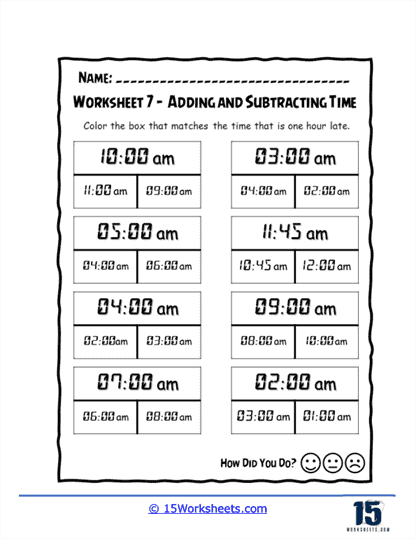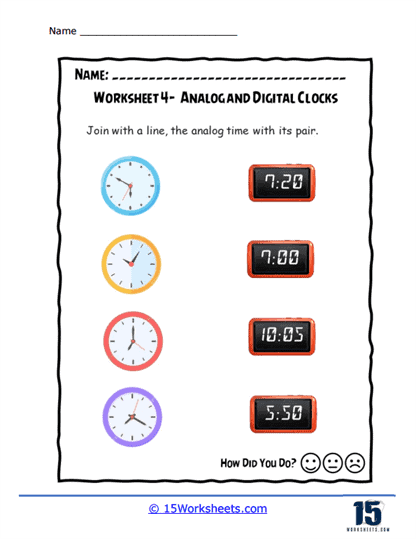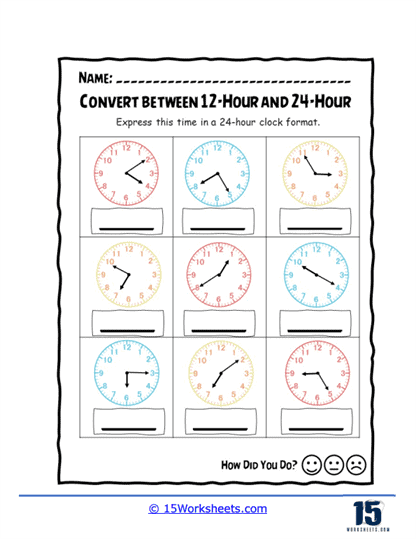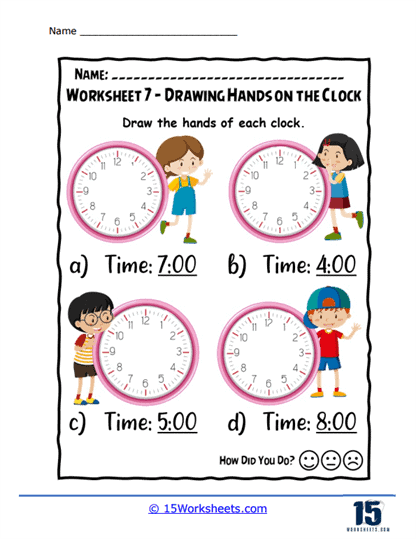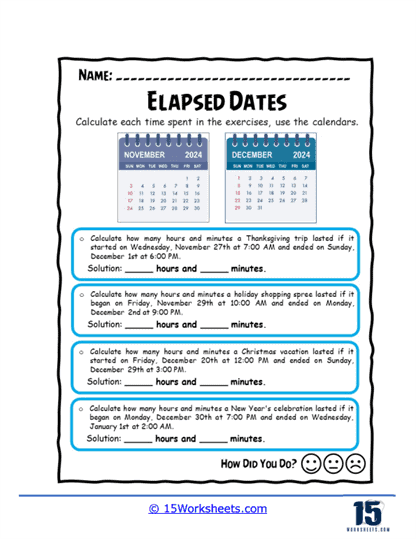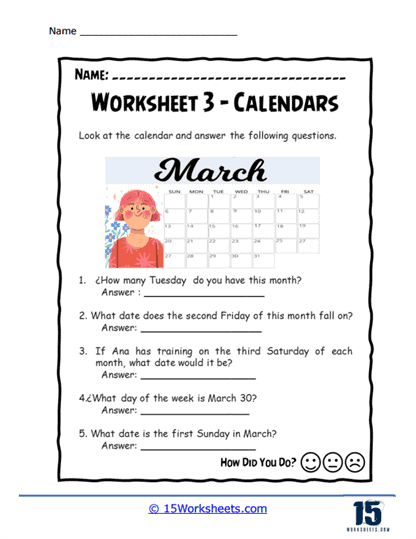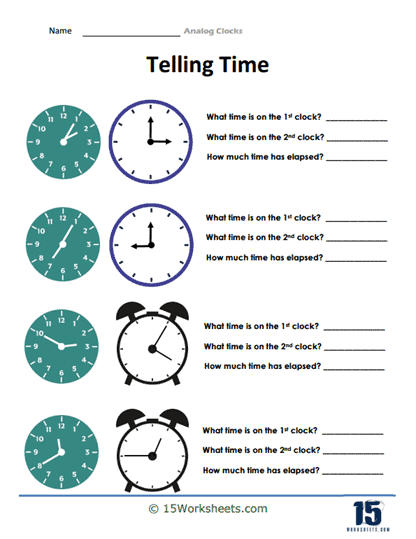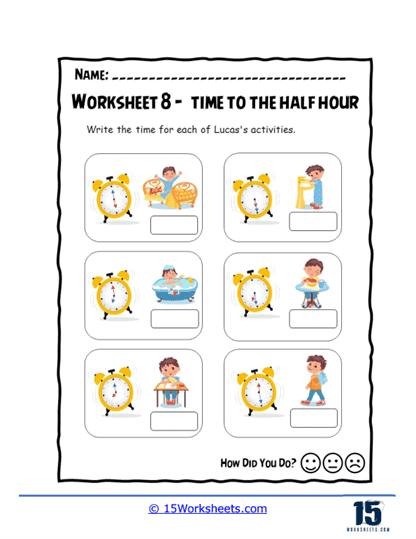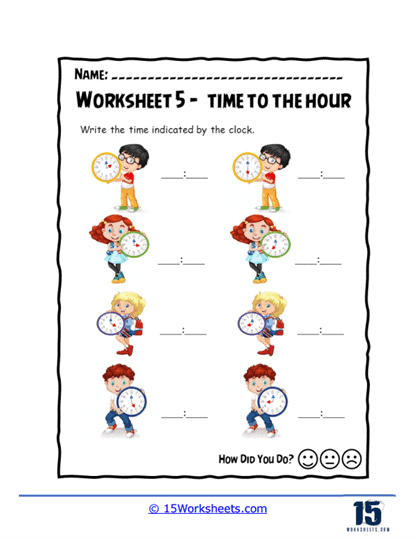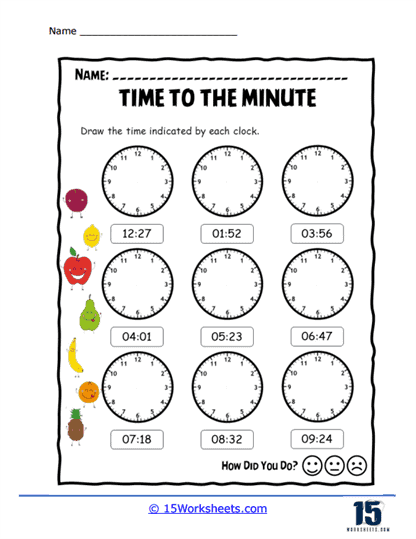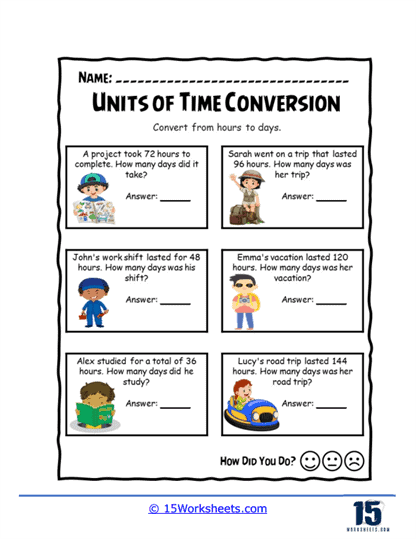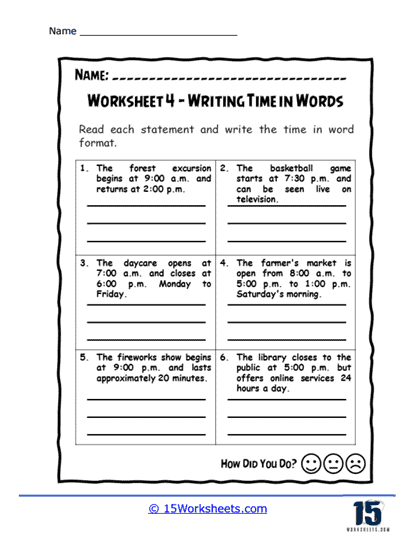Time Worksheets
About These 15 Worksheets
These worksheets are used to help students understand and master the concept of time. These worksheets cover a variety of topics, ranging from basic time-telling skills to more complex concepts like calculating elapsed time or converting between different time formats. Time worksheets are commonly used in elementary and middle school curricula to develop students’ time management skills, numerical proficiency, and ability to perform arithmetic operations involving time. They provide a structured way for students to practice and reinforce their knowledge through a variety of exercises and problems.
Types of Exercises and Problems
Adding and Subtracting Time
Adding and subtracting time involves calculating the total amount of time passed or remaining by performing arithmetic operations on hours and minutes. Students might be given problems such as adding 2 hours and 45 minutes to 1 hour and 30 minutes or subtracting 1 hour and 15 minutes from 3 hours. These exercises help students understand the concept of carrying over (when minutes exceed 60) and borrowing (when minutes are insufficient for subtraction). They also enhance students’ ability to perform arithmetic operations involving regrouping. Examples of problems might include word problems like “John started his homework at 4:30 PM and finished at 6:15 PM. How long did he take?” or straightforward arithmetic such as “Add 1 hour and 50 minutes to 2 hours and 35 minutes.” These exercises are fundamental in developing students’ skills in managing and calculating time intervals in real-life scenarios.
Analog and Digital Clocks
Worksheets featuring analog and digital clocks are designed to help students learn to read and interpret time in both formats. Exercises might include matching times shown on analog clocks with their digital counterparts or vice versa. Students could be asked to draw the hands on an analog clock to represent a given time or to write the time shown on an analog clock in digital form. This type of exercise reinforces the understanding of the relationship between the two time formats and helps students transition between them effortlessly. It also aids in recognizing the position of the hour and minute hands and how they correlate to digital time displays.
Calendars
Calendar worksheets involve exercises that teach students how to read and interpret calendar dates, days of the week, and months of the year. Problems might include questions like “What day of the week is June 14?” or “How many days are there in February?” These exercises help students understand the structure of a calendar year, including the concept of leap years, and develop skills in planning and organizing activities over days, weeks, and months. Students might also be asked to calculate the number of days between two dates or to identify specific dates based on given information. Understanding calendars is crucial for time management and planning skills.
Convert Between 12-Hour and 24-Hour
Conversion exercises between 12-hour and 24-hour formats help students understand the two different systems of telling time. Worksheets might present times in one format and ask students to convert them to the other, such as converting 3:45 PM to 15:45 or 18:30 to 6:30 PM. These exercises reinforce the understanding of the distinction between AM and PM and the use of military time. They also help students become familiar with the practical applications of both time formats, such as in travel schedules, digital clocks, and timetables.
Drawing Hands on the Clock
In these exercises, students are given a specific time and asked to draw the corresponding positions of the hour and minute hands on an analog clock. This type of problem helps students understand the movement of the clock hands and how they represent different times. For example, they might be asked to draw the hands to show 7:15 or 2:45. These exercises are excellent for developing fine motor skills and reinforcing the concept of hours and minutes. They also help students visualize time and understand the increments of time in a more concrete way.
Elapsed Dates
Elapsed dates worksheets involve calculating the amount of time that has passed between two dates. Students might be asked to determine how many days are between May 1 and June 15 or to calculate the number of weeks from one date to another. These exercises help students develop skills in addition and subtraction involving days, weeks, and months. They also enhance their understanding of the calendar system and its application in real-life situations, such as planning events or understanding the duration of projects.
Elapsed Time
Elapsed time worksheets focus on determining the amount of time that has passed between two given times. Students might be presented with problems like “If a movie starts at 7:30 PM and ends at 9:15 PM, how long is the movie?” or “Calculate the time elapsed between 8:45 AM and 3:00 PM.” These exercises help students develop skills in subtraction involving hours and minutes, as well as understanding and calculating time intervals. They are essential for time management and planning activities, as well as for understanding schedules and durations.
Estimating time worksheets involve exercises where students make educated guesses about the duration of various activities. For example, they might be asked how long they think it takes to walk a mile or to complete a specific task. These exercises help students develop a sense of time and improve their ability to make reasonable estimates. They also enhance their understanding of different time durations and their practical applications. Estimating time is a valuable skill in everyday life, helping with planning and time management.
These worksheets include exercises where students match prepositions like “at,” “on,” and “in” to specific time phrases, such as “at 5 o’clock,” “on Monday,” or “in January.” Other exercises might involve filling in the blanks in sentences with the correct prepositions of time, reinforcing their proper usage. Some worksheets may include sorting activities where students categorize different time-related phrases under the appropriate prepositions. Additionally, there are often contextual sentence-writing tasks where students create their own sentences using the correct prepositions of time, helping to solidify their understanding through application.
Telling Time
Telling time worksheets help students learn to read and interpret times shown on analog and digital clocks. Exercises might include reading the time from a clock face and writing it down, or matching times shown on different types of clocks. These problems reinforce the basic skills of identifying the hour and minute hands and understanding their positions on the clock face. They also help students become proficient in reading both analog and digital clocks, which is a fundamental skill for everyday activities.
Time to the Half Hour
Worksheets focusing on time to the half-hour help students understand the concept of half past an hour. Exercises might include drawing the hands on a clock to show times like 3:30 or identifying the time shown on a clock face that reads 6:30. These problems reinforce the idea that 30 minutes past the hour is represented by the minute hand pointing to the 6. They also help students understand the division of an hour into two equal parts and become comfortable with telling time in half-hour increments.
Time to the Hour
Time to the hour worksheets involve exercises where students learn to read and interpret times that fall exactly on the hour. Problems might include drawing the hands on a clock to show 5:00 or identifying the time shown on a clock face that reads 8:00. These exercises help students understand the basic concept of hours and how the position of the hour hand indicates the time. They also reinforce the idea that when the minute hand points to the 12, the time is exactly on the hour.
Time to the Minute
Worksheets focusing on time to the minute involve more detailed exercises where students read and interpret times that include hours and specific minutes. Problems might include reading a clock face that shows 2:47 or drawing the hands on a clock to represent 11:23. These exercises help students develop a precise understanding of time and improve their ability to read clocks accurately. They also enhance their skills in identifying the exact positions of the hour and minute hands for specific times.
Time to the Quarter Hour
Time to the quarter-hour worksheets involve exercises where students learn to read and interpret times that fall at 15-minute intervals. Problems might include identifying the time shown on a clock face that reads 7:15 or drawing the hands on a clock to show 3:45. These exercises help students understand the concept of quarter past and quarter to the hour. They also reinforce the idea that 15 minutes is a quarter of an hour and help students become comfortable with telling time in 15-minute increments.
Units of Time Conversion
Worksheets focusing on units of time conversion involve exercises where students convert between different units of time, such as seconds, minutes, hours, days, weeks, and months. Problems might include converting 120 minutes to hours or 3 days to hours. These exercises help students understand the relationships between different time units and develop skills in multiplication and division. They also enhance their ability to perform arithmetic operations involving time and understand the practical applications of these conversions in everyday life.
Writing Time in Words
Writing time in words worksheets involve exercises where students convert digital or analog times into written form. Problems might include writing “4:30” as “four thirty” or “7:15” as “quarter past seven.” These exercises help students develop their language and writing skills and improve their ability to express time in words. They also reinforce the understanding of the relationship between numerical and verbal representations of time and enhance their proficiency in communicating time accurately.
The Importance of Understanding Time
Understanding how to tell time and measure it accurately is an essential skill that permeates virtually every aspect of our daily lives. At the most fundamental level, telling time enables us to organize our days effectively. From waking up in the morning to going to bed at night, our activities are structured around specific times. Knowing how to tell time ensures that we can adhere to schedules, whether it’s getting to work or school on time, meeting deadlines, or attending appointments. This ability to manage and allocate time efficiently is crucial for maintaining order and productivity in our lives.
Beyond personal scheduling, the ability to tell time plays a critical role in social coordination and interaction. Our social lives are heavily dependent on time agreements. Meeting friends for dinner, attending a family gathering, or participating in community events all require a shared understanding of time. Without the ability to tell time, it would be nearly impossible to coordinate such activities, leading to confusion and missed opportunities for social engagement. This shared temporal understanding fosters cooperation and community, allowing people to synchronize their activities and interact harmoniously.
In the professional realm, time management is an indispensable skill. The workplace demands punctuality, adherence to deadlines, and efficient task management, all of which hinge on the ability to tell time accurately. Professionals use time to structure their workday, prioritize tasks, and achieve goals. For instance, project managers must create timelines and schedules to ensure projects are completed on time. Healthcare professionals rely on precise timing to administer treatments and schedule patient appointments. Thus, a strong grasp of time measurement directly impacts productivity and effectiveness in professional settings.
In our personal lives, time management influences our health and well-being. Knowing how to measure and allocate time allows individuals to balance work, leisure, and rest effectively. It helps in establishing routines, such as regular exercise, meal times, and sleep schedules, which are crucial for maintaining physical and mental health. Effective time management reduces stress by providing a sense of control and predictability in daily activities.

